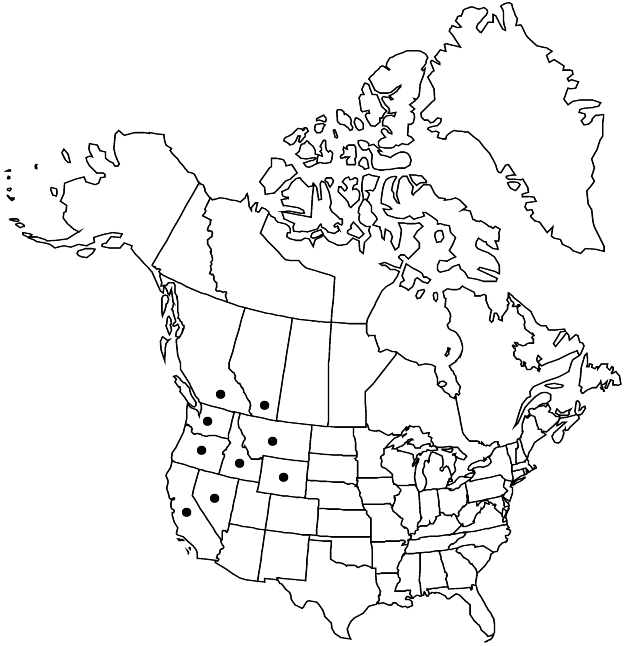Difference between revisions of "Polygonum austiniae"
Bull. Calif. Acad. Sci. 1: 212. 1885.
FNA>Volume Importer |
imported>Volume Importer |
||
| (5 intermediate revisions by 2 users not shown) | |||
| Line 8: | Line 8: | ||
}} | }} | ||
|common_names=Mrs. Austin’s knotweed | |common_names=Mrs. Austin’s knotweed | ||
| + | |special_status={{Treatment/ID/Special_status | ||
| + | |code=E | ||
| + | |label=Endemic | ||
| + | }} | ||
|basionyms= | |basionyms= | ||
|synonyms={{Treatment/ID/Synonym | |synonyms={{Treatment/ID/Synonym | ||
|name=Polygonum douglasii subsp. austiniae | |name=Polygonum douglasii subsp. austiniae | ||
|authority=(Greene) E. Murray | |authority=(Greene) E. Murray | ||
| + | |rank=subspecies | ||
}} | }} | ||
|hierarchy=Polygonaceae;Polygonaceae subfam. Polygonoideae;Polygonum;Polygonum sect. Duravia;Polygonum austiniae | |hierarchy=Polygonaceae;Polygonaceae subfam. Polygonoideae;Polygonum;Polygonum sect. Duravia;Polygonum austiniae | ||
| Line 35: | Line 40: | ||
-->{{#Taxon: | -->{{#Taxon: | ||
name=Polygonum austiniae | name=Polygonum austiniae | ||
| − | |||
|authority=Greene | |authority=Greene | ||
|rank=species | |rank=species | ||
| Line 49: | Line 53: | ||
|publication title=Bull. Calif. Acad. Sci. | |publication title=Bull. Calif. Acad. Sci. | ||
|publication year=1885 | |publication year=1885 | ||
| − | |special status= | + | |special status=Endemic |
| − | |source xml=https:// | + | |source xml=https://bitbucket.org/aafc-mbb/fna-data-curation/src/2e0870ddd59836b60bcf96646a41e87ea5a5943a/coarse_grained_fna_xml/V5/V5_1165.xml |
|subfamily=Polygonaceae subfam. Polygonoideae | |subfamily=Polygonaceae subfam. Polygonoideae | ||
|genus=Polygonum | |genus=Polygonum | ||
Latest revision as of 22:08, 5 November 2020
Herbs. Stems ascending to erect, green to purplish, much-branched from base, not wiry, 5–10(–20) cm, papillose-scabridulous. Leaves uniformly distributed, articulated to ocreae, basal leaves persistent, distal leaves abruptly reduced to bracts, articulated to ocreae; ocrea 3–5 mm, papillose-scabridulous or glabrous, proximal part funnelform, distal part lacerate; petiole 0.1–2 mm; blade 1-veined, not pleated, ovate to elliptic or obovate, 5–15 × 4–7 mm, margins flat or narrowly revolute, papillose-denticulate, apex acute or mucronate. Inflorescences axillary and terminal, spikelike, slender; cymes spaced along branches, 1–4-flowered. Pedicels exserted from ocreae, reflexed, 1–2.5 mm. Flowers closed; perianth (1.8–)2–2.6 mm; tube 20–28% of perianth length; tepals overlapping, green or purple, with narrow whitish margins, petaloid or sepaloid, oblong, cucullate, navicular, apex rounded; midveins unbranched; stamens 8. Achenes enclosed in perianth, black, elliptic to obovate, 2–2.5 mm, faces subequal, shiny, ± smooth.
Phenology: Flowering Jun–Sep.
Habitat: Dry to moist flats on banks, sagebrush plains, and ponderosa pine forests
Elevation: 1300-1600 m
Distribution

Alta., B.C., Calif., Idaho, Mont., Nev., Oreg., Wash., Wyo.
Discussion
Selected References
None.